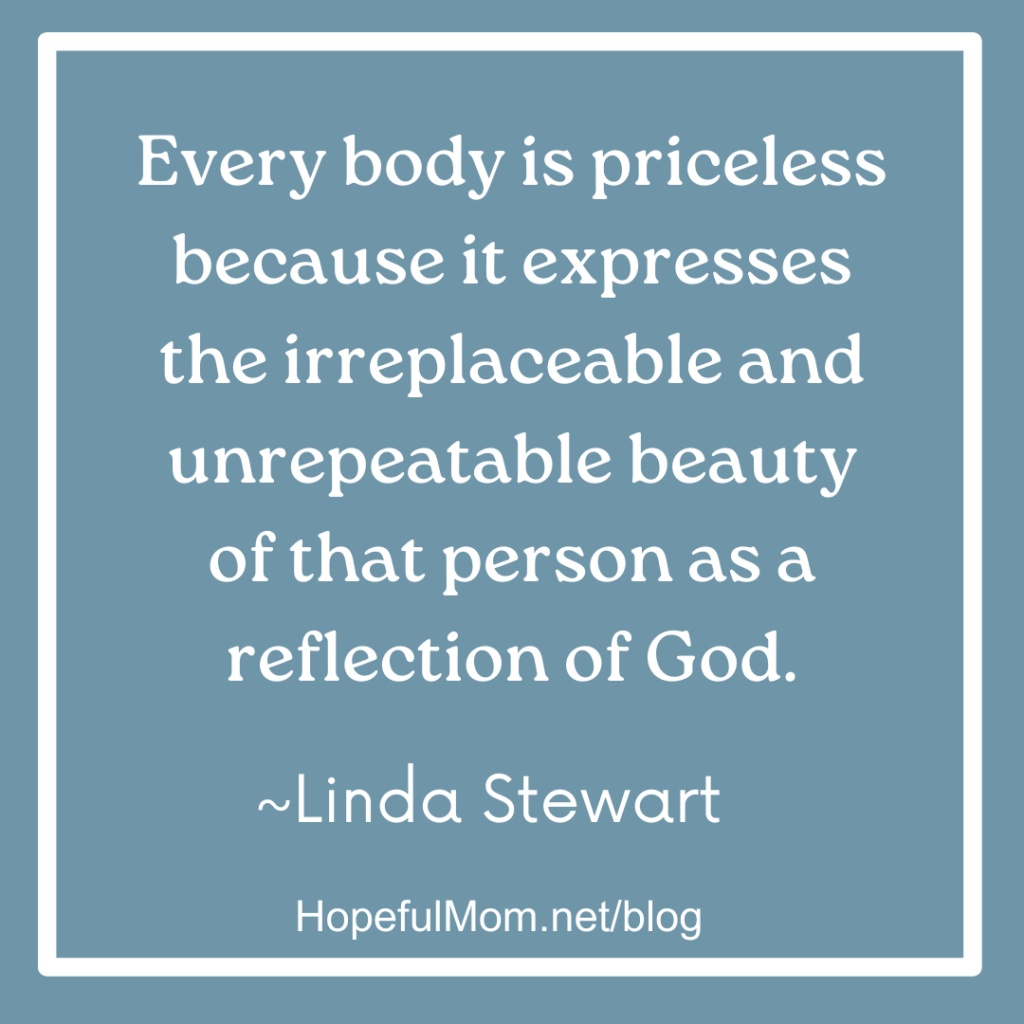Linda Stewart is back, continuing the conversation on how kids judge their bodies and how we and our children can learn to value the body. This topic is especially important since many preteens and teens learn to judge themselves based on what they see on social media and in pornographic videos. I learned so much in this post, and I’m sure you will find something valuable and applicable. If you haven’t already, read Kids Judge Their Bodies Part 1 here.
“How can I teach my kids to view theirs and others’ bodies without judgement?” The most effective way is probably the most difficult because it requires that we as parents, grandparents, and mentors deconstruct our own beliefs that affirm the body as a source of our value. If we can make the effort and begin this process so that we model the truth for kids, it can be so effective. We can demonstrate in our daily lives that every body is priceless because it expresses the irreplaceable and unrepeatable beauty of that person as a reflection of God. We can model this truth through our treatment of our own and others’ bodies.

Another practical approach to the value of the body is to affirm the body as an expression of who we are rather than an acceptable or unacceptable (depending on the day) accessory to who we are. Some examples:
"The body is an expression of who we are rather than an accessory to who we are." Kids Judge Their Bodies: What Can We Do? – guest post by Linda Stewart #hopefulmom #mentalhealth Share on X– When a child comments about her body’s appearance, bring the conversation back to how her body expresses her person. One example is the story of a teen who expressed serious concern over scarring from a surgical procedure. While really listening to this teen and hearing his experience, I also offered a different perspective that brought the conversation back to his whole, embodied person: “Just think of all the scars and marks that your body collects over the course of your lifetime. One of the ways your body expresses who you are is by keeping track of some of the experiences along the way that make you, you.”
– Any time you receive an innocent comment from a young child about the size or shape of your body, any scars, shape of your tummy, or even the skin hanging on your arms, (please tell me I’m not the only one!) address your response to the body part mentioned and connect it with the way that part expresses something about you as a person with unrepeatable and inestimable value:
- “No one else in the whole world has my arms. My arms carried you when you were little, hold you when you’re sick, and tickle you when you ask me to. My arms help me to express my love for you and others.”
- “No one else in the whole world has my stomach. My stomach digests my food so that I have good energy for work or play each day. My stomach tells me when I’m feeling nervous or excited or hungry or full.”
– If you have or work with older children, make different connections. Gently but consistently challenge statements your teen makes about his body as the source of his value. Affirm your teen’s body as an unrepeatable and irreplaceable expression of who she is in those moments that she draws value from her appearance. For example:
- “When I look at you, I see your incredible smile that makes people feel comfortable and loved!”
- “Please don’t talk negatively about yourself. When I look at you, I see how you love others, help strangers and friends, and how you laugh and joke the way only you can. You are literally one-of-a-kind. I love getting to know more about you and getting to know God better through you by experiencing how you see the world.”
We hope our kids see themselves and others as whole embodied persons of inestimable value and worth. They are inundated with messages that convey the opposite; that value and worth are judged based solely on the body’s appearance. Instead of unintentionally affirming this damaging message, let’s work together to make sure kids understand the body’s appearance is an unrepeatable and irreplaceable expression of who we are as human persons made in God’s image. You give your child(ren) a profound gift any time you cast a bigger and more beautiful vision for the body as a priceless expression of each unrepeatable person.
If talking about our embodied persons in this way intrigues you, I wanted to let you know that this and other topics are covered in our blogs and podcasts.
Have you explored the shop page at Hopeful Mom yet? There are several new items available, including two downloadable booklets. These are perfect for the parent who has learned their child has been exposed to pornography.
About the author

Linda M. Stewart, MA, LMFT
Linda Stewart is co-founder of THE Conversation Workshop, and owner of Collaborative Therapy Center where she works with women and couples. She integrates Theology of the Body into her therapeutic work, and speaks to therapists, church leaders, parents and premarital couples about “this beautiful vision for the body, relationships and sex.” Linda co-authored the book, Before the Sex Talk: A Theology of the Body Approach for Parents and Mentors. She serves on the Board of the Sexual Integrity Leaders. Linda lives and has fun with her family in Southern California.


